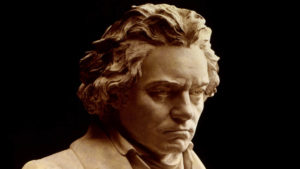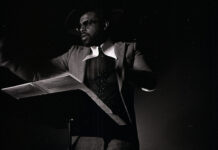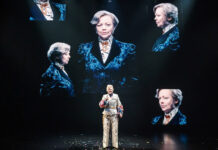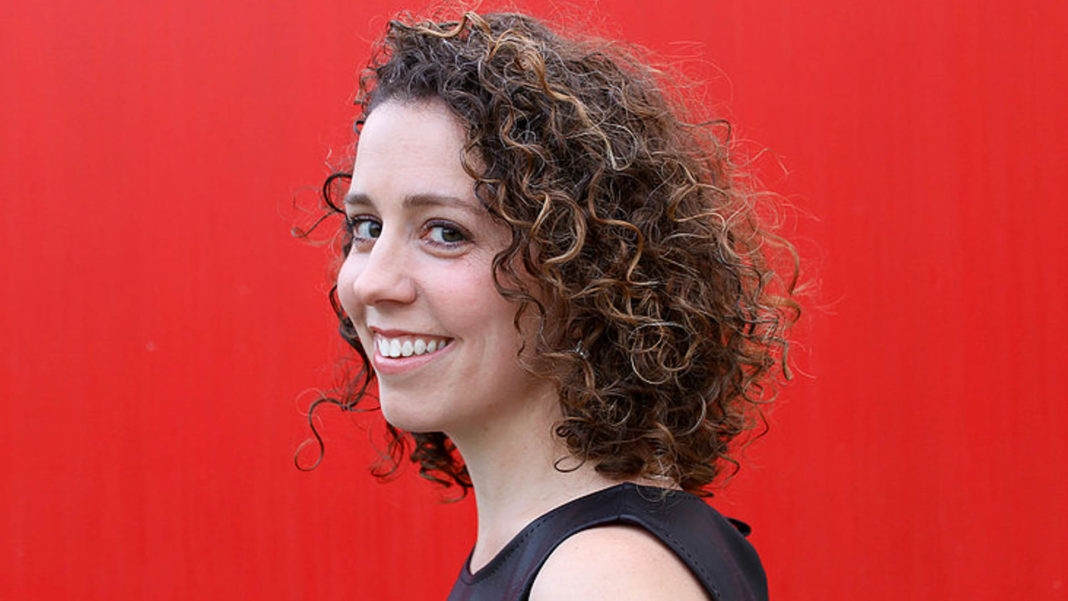The Los Angeles Chamber Orchestra has two concerts this weekend. On the program are two pieces you know very well: Beethoven’s 5th Symphony and Mozart’s Piano Concert in G Major. There’s also the Andante for Strings by Ruth Crawford Seeger who is a little known composer of the 20th century. But what stands out most on this program is the world premiere of warp & weft by composer Sarah Gibson.
Of course, if you participate in LACO’s Sound Investment program, you might already know Sarah Gibson. After all, the program allows members of the public to serve as fellow commissioners of new work by composers. For a minimum investment of $300, they get to attend various salons where Gibson talks about the work, previews its progress and gets to see the world premiere at one of the two concerts. Matthew Aucoin was a previous recipient of the Sound Investment program.
Gibson is a pianist, composers and teacher. Her compositions have won multiple awards (including the USC New Music for Orchestra Award for her Left-Hand Piano Concerto.) She is part of the piano duo Hocket and she, along with Andrew Norman, is a leading teacher artist with the Nancy and Barry Sanders Los Angeles Philharmonic Composer Fellowship Program.
Gibson’s piece, warp & weft, takes its name from terms for weaving. When I spoke with Gibson, I asked her about the inspiration for her piece, having the public participate in its creation and the future of classical music.
What inspired your composition and what in your background lead to a title with terms associated with weaving?
One thing that my compositions are often inspired by is artwork. I was interested in the artwork of Miriam Schapiro. She was one of the founding artists of the feminist art movement. There’s this term that she came up with I found inspiring, “femmage.” She defines this word to mean any artwork that was traditionally attributed to women at the how and was under-appreciated. What she did in order to pay tribute to this term in her paintings is she would sew fabrics or weave things in to combine different mediums.
My mom sews a lot and I did all sorts of arts and crafts growing up. I was thinking of these two terms and they feel very musical to me. If you were to take the warp and make it vertical, I see it as vertical stacked chords and harmonies and then the growth of the melody as the horizontal. It was the integration of the two on the page that is the inspiration for the piece.
Did LACO’s Sound Investment make possible something that had been brewing already or did warp & weft arise specifically out of this commission?
When this commission came along, I hadn’t thought about an orchestra piece in a while. So I was exciting to get the opportunity – those don’t come along every day to write, especially for LACO. The wheels started turning and I had to find a piece of art. When thinking of an ensemble that large, I wanted to have a visual, even if it isn’t a specific piece of art that I’m inspired by, rather than an overall point-of-view. I knew it was going to be a 13-15 minute piece. I knew I would have a year to work on it. I wanted to have something that could help gets those creative juices flowing besides just the music.

How does it feel to be the opening act for Beethoven’s most famous symphony?
It feels crazy. They just put out a short video ad for the concert and it has Beethoven, Mozart and my picture and then there’s “bum bum bum bum.” I’m very excited to be on a program with Beethoven.
Do you see a through-line from which we can get from warp & weft back in time to his symphony?
Oh wow. I can give you a through-line. I am a pianist and I’m still active as a performer [she is part of Hocket, where she pairs with pianist Thomas Kotcheff to perform cutting-edge music for two pianos] and all of my music is intrinsically influenced by me being a performer and me growing up with the standard repertoire. One thing that I love about both Beethoven and Brahms is that they are very motivic composers. Growing up playing Beethoven is something I think about a lot when I’m composing which is development. That might sound expected, but I like to think of myself as a harmonic and melodic and motivic composer.
When I listen to a lot of contemporary composers, it seems as though deconstruction is more important than melody at times. You don’t strike me as someone afraid of melody or melodic lines. Where does that instinct come from?
I’m not. I’m glad you picked up on that. I think that new music is this really interesting world. I play almost exclusively new music. I think one thing that the Sound Investment program offers is the people involved get a couple listenings because they get to go to rehearsals and hear me talk about it. I think it’s always interesting for a new music composer to hear something for the first time and have no idea who the composer is. And the audience, too. I love hearing new things, but it always feels good to hear a tune. Even if it is an out-there tune, pushing the envelope, if it is at the forefront one can relate to it.
How important will subsequent performances of new works be to you and other composers. Don’t they have to have more than just premieres?
I have a zillion chamber pieces that have been played twice. A third performance is amazing. The fact that this piece is being played twice is already such a gift.
You’ve spent a lot of time in Los Angeles. What is the state of classical music here?
I think Los Angeles is the place to be for classical music. When you look at what large organizations like LACO and the LA Philharmonic do to support new music, they are making it expected and part of the fabric, rather than unwanted and unique. That is what this genre needs. I think for me, LA also thrives off of these exciting artistic venues. I think about the museums downtown, the Broad, MOCA and being in relationship to all this musical organizations incredibly exciting.
What have you learned most about yourself as a composer vis-a-vis Sound Investment?
It has confirmed for me that collaboration is integral to my musical process. And one thing I didn’t know is that it helps me to talk about my music. I didn’t realize how much that would help me in formulating my process. And also digesting what I’m doing and holding myself true to what I say I’m doing.
The other thing is it really encouraged me that orchestral music is a living organism that is supportive and that wants new music. I love when I’m going for a run and all of a sudden I get ideas and I have to go home and write. It’s the life of an artist, but I wouldn’t have it any other way.
Los Angeles Chamber Orchestra concerts will be held on Saturday, January 26th at the Alex Theatre in Glendale and on Sunday, January 27th at UCLA’s Royce Hall. Hocket will have a performances on February 26th. at USC and CSUN on February 27th.










